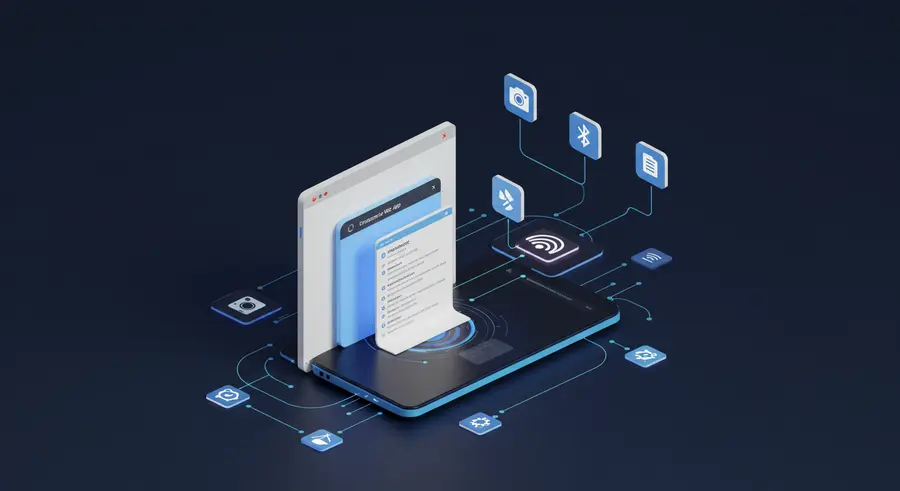Appearance

Welcome, tech enthusiasts! 👋 Today, we're diving deep into the exciting evolution of Progressive Web Apps (PWAs), focusing on their ever-increasing ability to interact with device hardware. Gone are the days when web applications were confined to basic browser functionalities. PWAs are bridging the gap between web and native, offering richer, more integrated experiences.
The Evolution of PWAs: From Basic to Brilliant 🌟
Initially, PWAs gained popularity for their core features: reliability (offline access), speed, and engagement (installability, push notifications). However, the journey didn't stop there. As web technologies mature, so does the ambition for what web applications can achieve. The drive to provide native-like experiences directly from the browser has led to significant advancements in Web APIs, enabling PWAs to tap into the underlying device hardware.
Deep Dive into Hardware Access: What's Possible Today? 📱💻
The ability of PWAs to access hardware is powered by a suite of modern Web APIs. These interfaces allow web applications to request permissions and then interact with various device capabilities, enhancing functionality and user experience dramatically.
Here are some key examples:
- Camera and Microphone Access: Imagine a PWA for video conferencing or photo editing. With the Media Devices API (
getUserMedia), PWAs can access the device's camera and microphone, enabling real-time communication, photo capture, and even augmented reality experiences directly in the browser.javascriptnavigator.mediaDevices.getUserMedia({ video: true, audio: true }) .then(stream => { // Use the stream (e.g., display in a <video> element) }) .catch(error => { console.error('Error accessing media devices:', error); }); - Geolocation API: Location-based services are fundamental to many modern applications. Whether it's a map application, a local business finder, or a fitness tracker, the Geolocation API allows PWAs to get the user's current location with their permission.javascript
navigator.geolocation.getCurrentPosition(position => { const latitude = position.coords.latitude; const longitude = position.coords.longitude; console.log(`Latitude: ${latitude}, Longitude: ${longitude}`); }, error => { console.error('Error getting location:', error); }); - Bluetooth API: This is a game-changer for connecting PWAs with real-world devices. The Web Bluetooth API enables PWAs to discover and communicate with nearby Bluetooth Low Energy (BLE) devices. Think about controlling smart home devices, interacting with IoT sensors, or connecting to medical equipment directly from a web app.javascript
navigator.bluetooth.requestDevice({ filters: [{ services: ['heart_rate'] }] }) .then(device => { console.log('Connected to:', device.name); }) .catch(error => { console.error('Error connecting to Bluetooth device:', error); }); - File System Access API: For applications that deal with files (e.g., document editors, image manipulation tools), the File System Access API allows PWAs to read, write, and manage files and directories on the user's local file system. This provides a truly desktop-like experience.javascript
async function getFile() { try { const [fileHandle] = await window.showOpenFilePicker(); const file = await fileHandle.getFile(); console.log('File name:', file.name); } catch (error) { console.error('Error accessing file system:', error); } } - Vibration API: A subtle yet effective way to provide haptic feedback, the Vibration API allows PWAs to trigger device vibrations, enhancing user interaction and notifications.javascript
if (navigator.vibrate) { navigator.vibrate([200, 100, 200]); // Vibrate for 200ms, pause 100ms, vibrate 200ms } - Orientation and Motion Sensors: APIs like
DeviceOrientationEventandDeviceMotionEventprovide access to data from accelerometers, gyroscopes, and magnetometers. This opens up possibilities for immersive gaming experiences, augmented reality, and precise control based on device movement.
Bridging the Gap with Native Apps 🌉
The continuous expansion of Web APIs means PWAs are becoming increasingly capable of delivering experiences that were once exclusive to native applications. This convergence offers significant advantages:
- Wider Reach: A single PWA can run across multiple platforms (desktop, mobile, tablet) and operating systems, accessible via a URL.
- Lower Development Cost: Developers can leverage web technologies they already know, reducing the need for platform-specific codebases.
- Instant Updates: Updates are deployed directly to the web, bypassing app store review processes.
- Discoverability: PWAs are discoverable through search engines, just like regular websites.
Security and Permissions: A Responsible Approach 🔒
With great power comes great responsibility. Accessing sensitive hardware features requires explicit user permission. Browsers are designed to prompt users for consent before any hardware access is granted, ensuring privacy and security. Developers must follow best practices, requesting permissions only when necessary and explaining why they are needed.
The Future is Bright for PWAs ✨
The trajectory of PWA development points towards even deeper integration with device capabilities. As browser vendors continue to implement new Web APIs and refine existing ones, the line between web and native will blur further. This will empower developers to build even more sophisticated and engaging web applications that can truly leverage the full potential of modern devices.
For a foundational understanding of PWAs, check out our article: The Power of Progressive Web Apps (PWAs)
What hardware access capabilities are you most excited to see in future PWAs? Share your thoughts! 👇